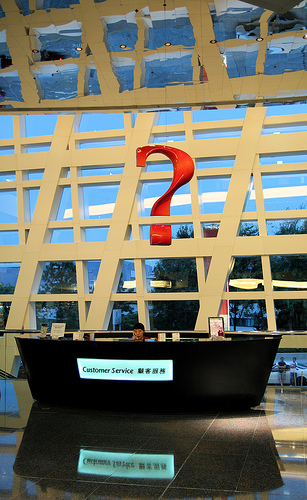 What is the real shift in how our students learn and how we teach?
What is the real shift in how our students learn and how we teach?
I spoke on the phone recently with a good friend of mine who taught with me an eon ago 😉 She went back to teaching last year for the first time in 15 years, and commented to me that when she taught before, the internet didn’t exist, and how much it had changed her practice and ability to find new connections for her students. It really drove home for me the fundamental change that access has provided for educators.
I’m following several passionate conversations about how our students learn and how we teach in the blogosphere lately, and have been thinking about Doug Johnson’s presentation at NECC, as well, where he talked about how the digital generation learns, all of which resonated with my own experience.
Considering how we can extend the focus of learning with web 2.0, Will Richardson asks:
“Through teaching them to use these tools to publish, are we also teaching them how to use these tools to continue the learning once that project is over? Can they continue to explore and reflect on the ideas that those artifacts represent regardless of who is teaching the next class? Can they connect with that audience not simply in the ways that books connect to readers (read but no write) but in the ways that allow them to engage and explore more deeply with an ongoing, growing community of learners? Isn’t that the real literacy here?”
He envisions that the change isn’t just the ability of students to publish, but to connect, and to reflect, and to be able to continue that life-long skill of reflection long after the class or assignment is over. He wonders if it is too easy to fall into the trap of using new tools just to produce different products for a wider audience.
David Warlick extends this conversation.
“What I seem to read in in his[Will’s] examples was an insistence among educators — traditional and progressive — to work toward final products. Instead of a book report or a graph in colored pencil, it’s a video or a podcast. In RL, so much of what we do never really gets finished.”
He goes on:
“I would rather not look at the production of a video or a podcast as the end of an assignment, but as the beginning or continuation of a conversation.
We are so focused, as educators, with what is learned. I wish we were more focused on learning.”
Why are things we do in education so finite? This assignment is over, that grade is turned in, this project is done, this course is over. Now we can move onto something unrelated.
(I know from working with students on their projects how easily the idea of completing the project distracts them from their process but that is another post.)
Where educators can and are most helpful is on keeping the focus on the thinking process involved. And we need to make sure that just because the students’ product is shiny and pretty, that there is thinking behind it and that it isn’t “the end of the road” for that assignment.
 How can we refocus students on the process? How can we extend the conversation beyond the specific project? And how can we connect cross curricular content so it’s more meaningful, as it is in the “real” world?
How can we refocus students on the process? How can we extend the conversation beyond the specific project? And how can we connect cross curricular content so it’s more meaningful, as it is in the “real” world?
I think one of the powerful things about blogs and also about social networks, is that you can create an ongoing community conversation as a class or as a school, which can serve to unite those discrete assignments or efforts into a more unified and continuous learning experience.
One of the most effective models I’ve seen for continuous learning and a focus on process and conversation is a strategy that several of our English teachers use, called Occassional Papers. I don’t know that my description is going to really do it justice here. But as I sit here and think about it, an occassional paper is like a blog post (except they were doing this well before blogs!)
Students write on a topic that arises for them….often a personal reflection, something they’ve realized or learned. The teachers in the class also write Occassional Papers. The students and teachers read their paper to the class, and then the class discusses the paper, ask questions, explore their ideas. As the semester goes on, this experience builds a community within the class. The teacher shares their personal reflections just as the students do, a participant in the process as well.
Why do I bring this up here? Because as I was reading what Will, David, and Clay Burrell had to say, I realized that what our teachers like Bill and Valerie and Carra are modeling in their classroom is the focus on the process, the focus on continuing the conversation, and on connecting. And that’s because the pedagogy is there, behind the scenes. Students are writing authentic pieces for an authentic audience, and sharing it with their class creates a connection and ongoing conversation built on reflection.
Web 2.0 tools give us a similar ability to engage in an ongoing, extended conversation, but beyond the walls of our own classrooms, libraries, or schools. It extends the power of our network. And I would say, it can become, as it has in political realms, a galvanizing force as we collectively share our inspiration, ideas, and efforts.
Christy Tucker sums it up excellently:
The network isn’t just a source of information; our connections actually help us make sense of that information. We see patterns in what people talk about and how they discuss it, and that helps us in our sensemaking. . . .
If I understand Will correctly, he’s hoping we can teach students to use the network as a way to make sense of the vast amounts of information now available to us. What the technology lets us do is connect with people so we can understand more and keep learning. We don’t have to stop learning when a course is finished; we can keep interacting with our network and learning together.
Learning together–isn’t that what education should be?
Images: http://www.flickr.com/photos/mworrell/266913194/;
http://www.flickr.com/photos/mworrell/266180687/
One of the things I’ve noticed is that when we ask students to follow an information problem solving model like the Big6, we tend to ignore the 1st step of defining the task and the last step of evaluating the product and the process. It’s the final step where we need to ask students to reflect on both how good their product was AND how effective they were in doing their work. I’d ask students to always answer the question “What will I do differently next time to improve my work and skills?”
Just a thought. Enjoyed your post,
Doug
I agree, Doug. How to get that across better or work as a team better with teachers is something I want to discuss and think about more.
By the way, I am planning another post on this idea of reflection and extending but more focused on the library specifically!
Thanks for the link and the compliment! I like how you summarized it here as focusing on the process rather than only the finished product. I wonder how assessment works when you’re focusing on the process though; if there’s too much focus on just the process, nothing would ever get finished. I’m not convinced that’s realistic; we do have to complete projects in the real world. The idea you shared about the Occasional Papers intrigued me because it does show end points, or at least milestones where a project winds down. I understand where David Warlick is coming from that much of learning is never finished, but I think we also have to make concessions to the idea that we need milestones along the way. I know that I need places to pause and reflect and get feedback in my own learning. Maybe that’s still process though, at a bigger level. Can it be a process with many products along the way?